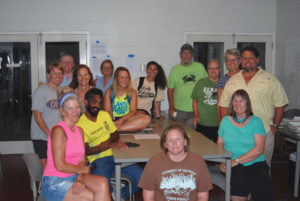Teachers Gather at Sapelo Island
A summer’s night had fallen on Sapelo Island, Georgia. Despite the coastal breeze, the air remained humid and sticky, the buzz of insects singing an evening chorus.

Teachers and GCE staff at the Schoolyard Program’s 2017 summer workshop.
Credit: E Zambello
The island was more crowded than normal. In addition to the usual researchers, graduate students, and interns, a group of K-12 teachers had gathered for a week-long immersion course as part of the Georgia Coastal Ecosystems (GCE) Schoolyard Program, and I was there to document the experience. After dinner, we walked to a small auditorium in one of the buildings, sitting together around circular tables facing a screen. One by one, GCE scientists and researchers stood up to explain their work in coastal Georgia and describe the field trip opportunities available throughout the week.
After a good night’s sleep in the dorms, I met with a handful of teachers the next morning at the boat docks in the marsh tidal creek. They were a mix of science, social studies and English instructors. Michelle, who teaches 10th-12th grade AP Government and Economics, told me that she finds the hands-on nature of the Schoolyard course inspiring. “What I’ve taken back to the classroom is not only the economic side of it, with scarcity and conservation of resources, but also that this experiential learning truly does have an impact and makes a more lasting impression,” she said,” So I try to take those types of techniques into my classroom and have my kids experience instead of just learning from a book.”
Connecting Teachers to Science
The GCE schoolyard program provides unique opportunities for K-12 teachers to immerse themselves in real science projects, taking back first-hand experience of the scientific method. Its mission is to immerse “science and math teachers in hands-on research activities in the field to enable them to bring lessons and actual research back to the classroom.
During their week out at the University of Georgia Marine Institute on Sapelo Island, teachers divide their time between assisting with research in outdoor settings alongside GCE scientists and graduate students and discussing the implementation of the information and experiences into their own teaching settings.

Research Technician Tim Montgomery records water quality data with a teacher during the GCE schoolyard summer workshop.
Credit: E Zambello
Living, breathing science
Our boat left the dock, captained by Tim Montgomery, one of the reserve’s research technicians. The teachers and I listened as he explained where and why the reserve scientists monitor t water quality in the estuary, and then—this was the fun part—we collected the data ourselves! The teachers scrubbed off the barnacles and marsh vegetation from the data loggers; they recorded measurements of salinity and depth; they watched herons and egrets take off from the muddy banks of the creeks; and squealed with delight when sea turtles popped their heads up mere yards from the boat. For each of them, science left the school’s labs and textbooks behind and became a living, breathing discipline.
Throughout the week, the teachers collected water samples from a cutgrass marsh, counted vegetative grasses in estuary plots, collected crabs, and so much more. When they return to their classrooms, they bring back firsthand accounts of doing science. The program is so successful that some teachers return for multiple summers, or come from across the country to take part. Even after their visit, teachers will stay in contact with the GCE-LTER Schoolyard, continually bringing real-life science to their students.
As one teacher put it: “I need this every summer to show myself and my kids that I am a scientist. Only now do I feel like I can call myself a science teacher…My kids believe me because they see the pictures of me really doing what it is I’m teaching them.”










